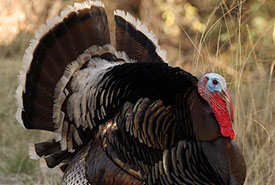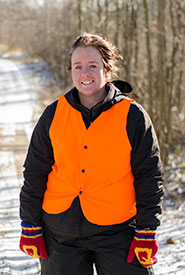Lovebirds: The day I broke a turkey's heart

Wild male turkey (Photo by Wayne Dumbleton, CC-BY-NC-SA 4.0)
One of my favourite field work stories comes from my very first field season. I’ll be the first to admit that I had no idea what I was doing back then. I couldn’t identify most plants, was slightly scared (ok, terrified) of dragonflies and went to the field wearing outfits that I would wear to work at my part-time retail job later in the day…What was I thinking?
Anyway, I remember it being a brisk morning in May. We were looking for individual plants of about 30 species in an old field at the Queen’s University Biological Station to monitor flowering time and plant size. We had no idea what species we were targeting, as the plants were too small that early in the season. Instead, we were simply looking for morphological differences and naming them something that we would remember. For example, poverty oat grass is a low-growing grass with soft, fuzzy leaves. As grasses are difficult to identify without flowers, in the earliest parts of the season we referred to poverty oat grass as “fuzzy grass.”
That morning I was working in a low-lying area of the field right next to some bushes at the treeline. I was uncomfortably crouching down, wearing dark jeans that had little movement in them, and my dressy brown blouse was catching in the wind and blowing up to meet my brown baseball cap. I had my back to the bushes and was busily searching the ground looking for “looks like marijuana plant.” I heard a rustle behind me and before I could even turn around, I glanced up at another field crew member who was standing about six metres in front of me. “Oh my God, turn around!” she exclaimed. I quickly turned my head and just a metre behind me was a huge adult male wild turkey. He emerged from the bushes and was fanning his beautiful, bright tail feathers and dragging his strong wings along the ground beside him.
I was frozen in place and had no idea what to do. I had seen plenty of wild turkeys in my life, but generally they had avoided me, like they do most humans. What on Earth was this turkey doing? Why was he?…Holy *&#%!…and then it came to me: He thought I was a turkey too. My wavy brown blouse, brown hat and crouched-down position probably made the poor guy think “Wow, now that is a big turkey…And she will be mine.” So out he came with his best face on, trying to impress me.
In a panic, I suddenly stood up. The turkey paused for a moment, let out a weird yelp and then a cluck. He jumped two feet in the air, spun around and crashed back into the bushes. I’m sure he was just as shocked about the whole situation as I was. The love of his life, the most beautiful hen he had ever set eyes on, was not actually a hen, but an awkward field biologist lurking in the grass. After that incident, I started wearing bright colours in the field, and now I never stay in the same spot for too long. I wouldn’t want to break another turkey’s heart.


